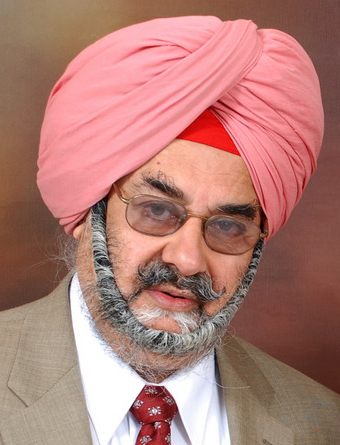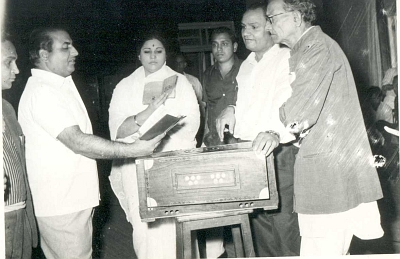|

MOHAMMAD
RAFI’S METEORIC RISE AFTER INITIAL HICK-UPS IN
BOMBAY

Harjap
Singh Aujla
Mohammad
Rafi was not a part of Master Ghulam Haider’s contingent, when he moved
from
Lahore
to
Bombay
in the end of 1943. But after receiving several calls from
Bombay
, Mohammad Rafi finally decided to leave
Lahore
for
Bombay
in 1945. While boarding the train in
Lahore
, he was seen off by hordes of hugging and emotionally charged friends and
relatives, but in
Bombay
there was no such scene. Hardly anyone turned up to receive him. This was
a big cultural shock, but Mohammad Rafi was too cool to be agitated by
such incidents. He had come to
Bombay
with a promise, which he had to fulfill at any cost.
Mohammad
Rafi sang a couple of film songs in 1945 in
Bombay
, but due to poor name recognition, these songs did not help him much.
However he was paid a lot better. All India Radio gave him rupees twenty
five for a whole day of singing in Lahore, but in Bombay he was paid,
during those days a whopping sum of rupees three hundred per film song. In
order to make both ends meet, he sang privately too in “Mehfils”,
among the Punjabi community of
Bombay
.
Mohammad
Rafi’s first big break came late in 1946. Shooting for a Dilip Kumar
Noorjehan starrer block-buster film “Jugnu” was started in 1946. This
film was directed by Sayyed Showqat Hussain Rizvi and its soul stirring
music was composed by Feroze Nizami on the lyrics contributed by Tanvir
Naqvi. All at one or the other time had moved from
Lahore
and other parts of
Punjab
to
Bombay
. By this time Noorjehan had already established herself as the leading
female film singer. Her competitor was another actress singer Suraiya.
Both hailed from
Lahore
district. Mohammad Rafi was from the neighboring district of Amritsar.
Noorjehan
was extremely jovial and witty. She was known to give tough time to her
competitors and co-singers. Strongly built, but petite in height,
Noorjehan was already in the sound recording studio for the recording of a
duet. She was expecting G.M. Durrani to be the other singer. But Feroze
Nizami had a better option. Feroze asked Mohammad Rafi to come for
rehearsal. When short simply dressed Mohammad Rafi arrived in the studion,
Noorjehan erupted into a loud laughter. Being still new in
Bombay
and pitted opposite a star singer Noorjehan, Mohammad Rafi got nervous.
Noorjehan smilingly asked Mohammad Rafi “So little chap you have finally
come to
Bombay
, welcome, welcome, how were things in
Lahore
?”. A nervous Mohammad Rafi remarked “Things are not bad in
Lahore
, every one over there was missing their baby Noorjehan. On hearing this
instant reply from otherwise a quiet man, everyone in the studio erupted
into a loud laughter. Most of the members of the orchestra were of course
Punjabis. Mohammad Rafi tried his best in rehearsals, but he was under a
complex that he was singing opposite a star. When the recording of the
duet song “Yahan badla wafa ka be wafayi ke siwa kya hai” was
completed, Mohammad Rafi had doubts about his performance. He wanted a
retake, but the music director said it is fine.
When
the film was released in 1947, this very duet became the best selling
song. This gave the necessary break to Mohammad Rafi and from then on he
never looked back and went from strength to strength.
Mohammad Rafi’s price tag per song recording jumped to rupees
five hundred, the same as Noorjehan’s.
After
the release of film “Jugnu”, Mohammad Rafi became a much sought after
playback singer. Ghulam Haider was composing music for another
block-buster film “Shaheed”. Surinder Kaur was its leading female
singer, but one song sung by Mohammad Rafi “Watan ki raah main watan ken
au jawan shaheed ho” became so popular that Mohammad Rafi became a
household name. This song was recorded in 1948 and released during the
same year.
Born
on
April 11, 1904
the reigning male singing star K.L. Saigal died on
January 18, 1947
at the age of forty two. Like a “Banyan” tree K.L. Saigal was larger
than life, no other singer could grow to potential under his shadow. Being
trained in
Calcutta
, K.L. Saigal’s style of singing had the tinge of semi-classical
musician with a Bengali finesse. But Mohammad Rafi’s style was a lot
more flexible and suitable for every actor. G.M. Durrani was another
Punjabi singer, who in years was senior to Mohammad Rafi. The top slot
left open by K.L. Saigal’s demise took
some time to be filled.
|

|
|
Pandit Husnalal rehearsing a tune with Muhammad
Rafi |
A
lot of music directors came forward to groom and polish the singing skills
of Mohammad Rafi. Among the foremost were Shyam Sunder (an import from
Lahore
), Pandit Husnalal Bhagatram (another import from
lahore
), famous drummer Ustad Allah Rakha (originally of Gurdaspur district)
Naushad Ali from U.P. and Sajjad Hussain. In fact once Sajjad Hussain
asked Mohammad Rafi to sing “Heer Waris Shah” for him. Mohammad Rafi
sang it with typical Amritsari slang. Sajjad composed its tune in his own
inimitable style. With a lot of effort Mohammad Rafi mastered the new
tune, but the end product was great.
Pandit
Husnalal offered to train Mohammad Rafi into a top notch film singer. When
Husnalal Bhagatram started their career as a duo of music directors in
1944, they depended thoroughly on the seasoned voice of Zeenat Begum a
discovery of their elder brother Pandit Amar Nath. But during the late
forties much shriller female voices started dominating the film scene.
Amongst men Mohammad Rafi was senior in years to Mukesh and Manna Dey.
Talat Mahmood had started earier than Mohammad Rafi in 1941 in
Calcutta
. But in Bombay Talat Mahmood came a couple of years later than Mohammad
Rafi.
When
the opportunities came Mohammad Rafi pounced on them. Then came
August 15, 1947
. What Mohamad Rafi observed will be covered in the next issue?
harjapaujla@gmail.com
BACK TO APNA WEB PAGE
|

